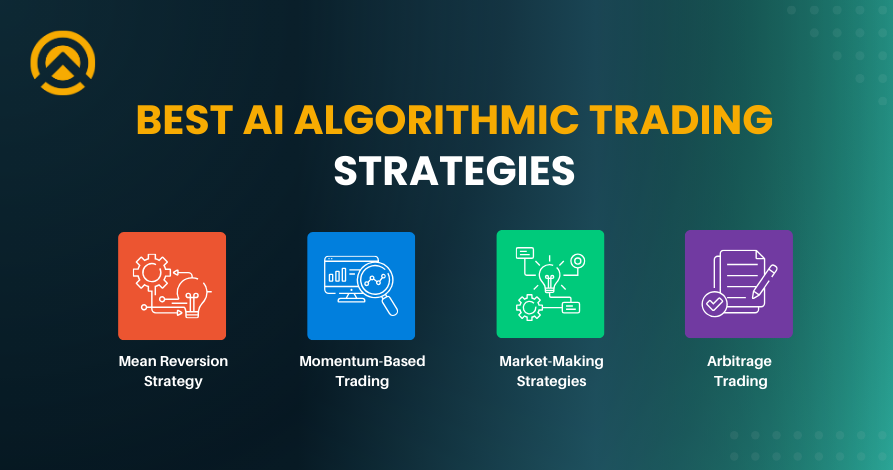AI Trading Bots: Why Most Fail and How to Build a Profitable System
Introduction
Do you want to know why AI trading bots fail? If yes, this article is for you! Here, we are going to talk about the key reasons behind the AI trading bot failures along with the comprehensive guide to developing successful automated AI trading software.
AI trading bots have created a big difference in the financial market by enabling traders to automate strategies and optimize performance. These advanced bots leverage advanced AI algorithms and machine learning techniques to analyze vast amounts of market data and execute trades with precision. The prime aim of automated AI trading bots is to reduce human errors, improve efficiency, and generate profits. But, despite the promise of success, many trading bots fail due to particular flaws in their design execution.
There are various reasons behind the failure of AI trading bots, and one of them is overfitting to historical data that leads them to poor adaptability to live market conditions. Apart from that, inefficient reinforcement learning strategies, high API latency, and a lack of real-time market adaptation all lead to low performance. In this blog, we are going to discuss why trading bots fail, how to build a profitable AI algorithmic trading system, and also the best AI algorithmic trading strategies to implement. This will help you know the common issues and solutions so that you can develop an advanced AI-driven trading bot for stock markets that will help you generate profit consistently.
Why Do AI Trading Bots Fail?
Here, we are going to know the key reasons behind the failure of the trading bot.
Overfitting to Historical Data
This condition happens when you use past market data to train an AI trading algorithm, and that makes it ineffective in a live market scenario. When backtesting is done, it may offer you great results. But, when you test it in the real-world scenario, then you will know when the trading bot is lacking. And in this, many traders fail to identify that market conditions change at an alarming rate, and for that, you have to update your trading bot accordingly.
Lack of Real-Time Market Adaptation
In the dynamic financial market, bots depend on historical data without real-time learning mechanisms. That’s why they perform badly when market conditions change. The bull market and the bear market are the two types of markets. And an AI trading bot that works well in a bull market may face issues in a bear market and cause a lot of loss. To address this problem, you have to feed real-time data and adaptive learning algorithms.
Inefficient Reinforcement Learning Strategies
Reinforcement learning plays an important role in AI trading. But sometimes, when implementing it in the AI trading software and reward mechanism is poor, it leads to poor decision-making. If your RL-based AI bot is not trained correctly, it may give priority to short-term gains over long-term profitability. And all that led to erratic trading behavior.
High API Latency & Execution Delays
In profitable trading, execution speed plays a vital role. AI trading software that faces API delays may miss profitable opportunities, and all that leads to loss. In high-frequency trading, every second matters, and sometimes, a delay of a few milliseconds can result in missed arbitrage opportunities or increased slippage.
Ignoring Market Liquidity and Slippage
Many AI trading bots for stocks fail to account for liquidity issues, and that causes slippage in trade execution and reduces profitability. Market impact is another key factor that should be counted when you design an AI trading strategy. It becomes more important in large trades that can shift market prices.
By addressing these challenges, traders can build a profitable AI trading bot. To develop successful AI agents, you can take the help of an AI agent development company.
Choosing the Best AI Algorithm for Stock Market Trading Automation
To develop a profitable AI trading system, you have to choose the right AI algorithm for it. There are different techniques, like machine learning and reinforcement learning, that offer distinct advantages to make your trading automatic. Machine learning techniques are used for pattern recognition and prediction modeling, and meanwhile, RL techniques are used to enable dynamic adaptation to ever-changing market conditions.
Comparing Machine Learning vs. Reinforcement Learning
Both machine learning and reinforcement learning play an important role in AI trading bots. Let’s start to know both of them in detail.
- Machine Learning: Machine learning is used to detect patterns and analyze trends. ML-based bots analyze historical market data to predict future price movements.
- Reinforcement Learning: It is more adaptive and learns from past trading actions. And refine strategies through trial and error.
In all that, ML is the best for static pattern recognition, and RL is the best in real-time decision-making and is used for algorithmic trading strategies that require continuous adaptation.
Supervised Learning for Pattern Detection
Supervised learning is a branch of machine learning that is widely used in AI-driven trading bots to identify patterns in stock price movements. When you train AI models on labeled historical data, AI can recognize patterns like:
- Moving averages crossovers (e.g., 50-day vs. 200-day moving average)
- RSI (Relative Strength Index) trends for overbought/oversold conditions
- Support and resistance levels for entry and exit points
Supervised learning offers a foundation for developing an AI trading algorithm that makes data-driven trade decisions according to historical trends.
Deep Reinforcement Learning for Dynamic Market Adaptation
Deep reinforcement learning enables automated AI trading bots to adapt to shifting market conditions. DRL-based trading bots use reward systems to optimize trading actions that make them more resilient to market volatility.
Key advantages of DRL in trading automation:
- Real-time decision-making based on live market data
- Adaptability to different market conditions (bull/bear markets)
- Continuous learning from past trades to improve performance
By implementing deep RL strategies, traders can enhance the profitability of AI trading software by reducing reliance on static models.
Also Read : Top Machine Learning Models Powering AI Innovations in 2025
Best AI Algorithms for Trading Bots
Several AI-driven algorithms power modern AI trading bots. The most effective include:
1. PPO (Proximal Policy Optimization): Balancing Stability and Adaptability
PPO is a reinforcement learning algorithm that is used to optimize trading strategies while maintaining stability. It prevents drastic trading fluctuations and ensures consistent improvements, which makes it suitable for profitable AI trading systems.
2. DDPG (Deep Deterministic Policy Gradient): Handling Continuous Action Spaces
Deep deterministic policy gradient is the best for automated AI trading bots that require continuous decision-making, like adjusting portfolio weights dynamically. This algorithm is useful for algorithmic trading strategies in volatile markets.
3. Transformer-based Models (GPT for Trading): Learning from Complex Sequences
AI models like GPT are used in AI-powered trading bots. These models analyze complex historical price sequences, new sentiments, and alternative data to enhance predictive accuracy. Transformer-based models can identify long-term dependencies in stock price movements that are not possible in traditional models.
Feature Engineering for AI Trading Models
Feature engineering plays an important role to enhance and maximize the accuracy of AI trading bots. Key trading indicators and alternative data sources that are used in AI-based trading are:
- Technical Indicators: Bollinger Bands, MACD, Stochastic Oscillators
- Sentiment Analysis: Analyzing news headlines and social media trends
- Alternative Data: Economic indicators, market sentiment, trading volumes
By integrating advanced feature engineering techniques, AI trading models can generate profitable algorithmic trading systems with higher predictive accuracy.
Also Read : 10 AI Agent Development Companies You Need to Know in 2025!
How to Build a Profitable AI Trading System in 7 Steps
To build a successful AI-driven trading system, you have to take care of various aspects, such as algorithms, data-driven decisions, risk management, and continuous improvement. Here, we are going to discuss the step-by-step process to develop AI trading bots that ensure maximize profitability while minimizing risks. Let’s start to know.
Gather and Prepare Market Data
When you are going to build a profitable AI trading bot, then the first thing you need is quality data. You have to enrich your artificial intelligence with real-time and historical market data from various resources like Binance, MT4, and Robinhood. But for this, you have to refine your data, and raw data cannot be used. To standardize price movement, you can remove anomalies, fill in missing values, and apply techniques like Z-score normalization. And to enhance predictive accuracy, you can add technical indicators (MACD, RSI, Bollinger Bands), sentiment analysis, and alternative data.
Define Your Trading Strategy
To build profitable AI trading software, a clear AI strategy is required. You have to know that your AI trading bot will use supervised learning for pattern recognition or reinforcement learning for adaptive decision-making. In this step, you have to decide what kind of AI model you want to develop, like a trend-following, mean-reverting, or arbitrage-based model. Always create a strategy that aligns with your risk tolerance and market conditions. The more you enrich your plan, the more your AI will be able to identify profitable trade opportunities and avoid random market noise.
Train Your AI Model
Once you have both data and strategy, the next step is to train AI model. For this, you can use deep learning, reinforcement learning, or a hybrid approach. For reinforcement learning, you have to set up a simulated trading environment where your AI learns from market fluctuations. You can also define a reward function that prioritizes profitability, low risk, and execution efficiency. Always train your AI in a way that it can learn from past mistakes and continuously refine its decision-making process to improve trade accuracy.
Backtest and Optimize the Model
When you are going to deploy your AI model in the market, test its performance using historical data. And for that, you can use backtesting, which allows you to know how your trading bot would act in different market conditions. Win rate, drawdown, Sharpe ratio, and risk-adjusted returns are the key metrics on which you have to focus. To achieve maximum profitability, you can fine-tune your model by using Bayesian optimization and hyperparameter tuning.
Simulate and Paper Trade
Jumping straight into live trading can be risky. So first, deploy your artificial intelligence in a paper trading environment where it can start trading with virtual money. There are various platforms like TradingView, QuantConnect, and Alpaca, where you can test your AI model in a real-time environment without financial risk. This process is done to check execution flaws, overfitting issues, and potential weaknesses so you can know your AI is ready to handle real money.
Deploy and Monitor in Live Markets
Once you have tested your artificial intelligence models in the simulations, then deploy them in a real-world trading environment. Now, you have to connect it with an exchange, ensure low-latency order execution, and implement safeguards like position sizing and stop-loss mechanisms. After this, continuously monitor the performance and check if it is adaptable to new conditions or not. In all this, automated risk management is important to prevent heavy losses.
Continuously Improve and Scale
When we develop AI trading software, you have to update it with new market data and advanced algorithms. Also, integrate reinforcement learning updates so that your AI model can adapt to changing trends. To maximize your profit and earnings, you can scale your strategy for different assets like stocks, crypto, forex, etc. A profitable AI trending system will evolve over time, and for that, you have to update it continuously.
Best AI Algorithmic Trading Strategies
The best AI algorithmic trading strategies use advanced ML and deep learning models to analyze market data, identify patterns, and execute trades with accuracy. These strategies are used to enhance trading efficiency. And to achieve efficiency, they optimize decision-making, reduce risks, and capitalize on real-time market opportunities. To create the best strategy, you can take the help of an AI consulting services provider.
Here, we are going to talk about the four AI algorithmic trading strategies so that you can know which strategy is used for which purpose.

Mean Reversion Strategy
This strategy is used to identify overbought and oversold stocks and execute trades according to historical price reversion patterns. In this, AI algorithms analyze moving averages, Bollinger bands, and relative strength indices to detect trading opportunities.
Momentum-Based Trading
In this strategy, AI is used to detect upward or downward momentum in stock prices and enter trades according to that. This strategy uses deep learning models to identify price momentum signals in real time.
Market-Making Strategies
This strategy is used to ensure liquidity in the market, and, for that, simultaneously, buy and sell orders are placed to profit from bid-ask spreads. AI-driven marketing strategies can dynamically adjust spreads based on real-data order book data.
Arbitrage Trading
This strategy exploits price discrepancies between different exchanges, relying on high-speed execution for consistent profitability. AI trading bots execute trades at lightning speeds to take advantage of market inefficiencies.
Also Read : Leading AI Development Companies Transforming the Future in 2025
AI Trading Bot Deployment & API Integration
The success of an AI algorithmic trading system depends a lot on how you deploy it. Let’s start to learn how you can seamlessly deploy AI-driven trending bots and integrate robust APIs for real-time market analysis and automated trading execution. Let’s start to know.
Connecting AI Bots to Trading Platforms
To successfully deploy an AI trading bot, you have to seamlessly integrate it with trading platforms through APIs. This ensures real-time market data access, automated trade execution, and portfolio management. For this, basically three types of APIs are used.
Robinhood API
With the Robinhood API, AI bots can execute trades, manage portfolios, and retrieve market data efficiently. By using this API, traders can automate stock trending, set stop-loss limits, and analyze historical data for better decision-making.
Binance API
AI-powered trading bots use the Binance API to automate crypto trading. They help with high-speed trading, price differences across markets, and analyzing order books. Binance’s WebSocket and REST APIs provide live price updates, execute trades, and track account balances in real time.
MT4 API
For forex and futures trading, the MT4 API is used. And it enables AI trading bots to analyze forex charts, execute trades based on custom algorithms, and optimize risk management strategies. It supports algorithmic trading using MQL4 scripts that allow traders to automate strategies with precision.
For successful API integration services and deployment, always hire an experienced and reliable AI integration service provider.
Cloud Deployment & Scaling
Cloud-based deployment allows AI trading bots to operate efficiently without hardware limitations. All that ensures low-latency execution and scalability, which are important for high-frequency and AI-driven trading.
Using AWS/GCP for Low-Latency Execution
Cloud platforms like AWS (Amazon Web Services) and GCP (Google Cloud Platform) provide high-performance computing environments with ultra-low latency. Deploying AI trading models on cloud instances with GPUs enhances real-time decision-making and order execution speed.
Auto-Scaling AI Trading Models for High-Frequency Trading
High-frequency trading needs a system that can quickly adapt to market changes. Cloud-based auto-scaling helps AI models adjust their computing power based on trading activity, ensuring smooth performance, minimal delays, and faster trade execution.
When you integrate AI trading bots with these APIs and deploy them on scalable platforms, then it enhances trading efficiency, improves decision-making, and ensures real-time adaptability in volatile financial markets.
How Amplework Helps in Automated AI Trading Bot Development
Amplework is a prominent AI development agency that has been offering advanced AI solutions around the world across the industries. They specialize in developing custom AI trending bots that adapt to changing market conditions. By leveraging deep learning and reinforcement learning, our automated AI trending bots analyze market trends, identify patterns, and execute trades with high accuracy. Our AI models evolve over time and count real-time feedback to enhance performance and reduce risks.
To ensure seamless automation in the AI algorithmic trading system, we integrate AI trending bots with advanced platforms like Robinhood, Binance, and MT4 using their APIs. All that is done to automate trade execution, portfolio management, and real-time market tracking without manual intervention. The best thing you get is that our AI bots are designed for scalability, and for that, cloud-based solutions to support high-frequency trading. With continuous updates and refinement, we ensure that the AI-driven trading system remains efficient, adaptive, and consistently profitable.
For all kinds of automated AI trading bot development, you can also hire AI experts who will shape your AI trading system in a perfect way. For all kinds of AI software solutions, you can contact us anytime.
Final Words
To build a profitable AI trading system, you have to select the right algorithm, implement robust risk management, and ensure real-time adaptability. Once traders know why most of the AI trading bots fail, they can develop an effective strategy to navigate financial markets successfully. When you develop AI trading software, that doesn’t mean that your task has been completed. To stay competitive in the market and drive innovation, you have to update it from time to time.
If you are planning to build an AI-driven trading bot, always focus on real-time adaptability, execution speed, and data-driven decision-making. Because all are important to create a big difference in the market. To simplify the process, you can also take the help of an artificial intelligence automation agency. We hope this blog helps you to know why most of the AI trading bots fail and how to give shape to develop a profitable AI algorithmic trading system.
Frequently Asked Questions (FAQs)
What are the key aspects of building a profitable automated AI trading system?
Here, we are going to discuss the key aspects that play an important role in building profitable, efficient, and adaptive AI-driven trading systems that maximize market opportunities while minimizing risks.
- Scalability and cloud deployment
- Data quality is important
- Choose the right AI algorithms
- Backtesting and live testing
- Risk management is essential
- Continuous model optimization
- Seamless UPI integration
How does AI improve stock market trading strategies?
AI analyzes large datasets, identifies patterns, and executes trades at optimal times with high accuracy and speed to enhance trading strategies.
What is the best AI algorithm for automated trading?
The best algorithm depends on the strategy. PPO and DDPG are used for reinforcement learning, transformer-based models for pattern recognition, and traditional ML for trend analysis. To build AI trading bots, you can choose those that align with your business goals.
How can AI trading bots manage risk effectively?
Artificial intelligence bots use stop-loss mechanisms, position-sizing strategies, and real-time market monitoring to minimize losses and adjust trading behavior dynamically.
Which APIs are best for AI trading bot integration?
For AI trading bot integration, popular APIs are Robinhood for stock trading, Binance for crypto automation, and MT4 for forex and futures trading.
Can AI trading systems operate without human intervention?
Yes, AI trading bots can operate without human intervention. But periodic monitoring and strategy adjustments are needed for optimal performance.


 sales@amplework.com
sales@amplework.com
 (+91) 9636-962-228
(+91) 9636-962-228





